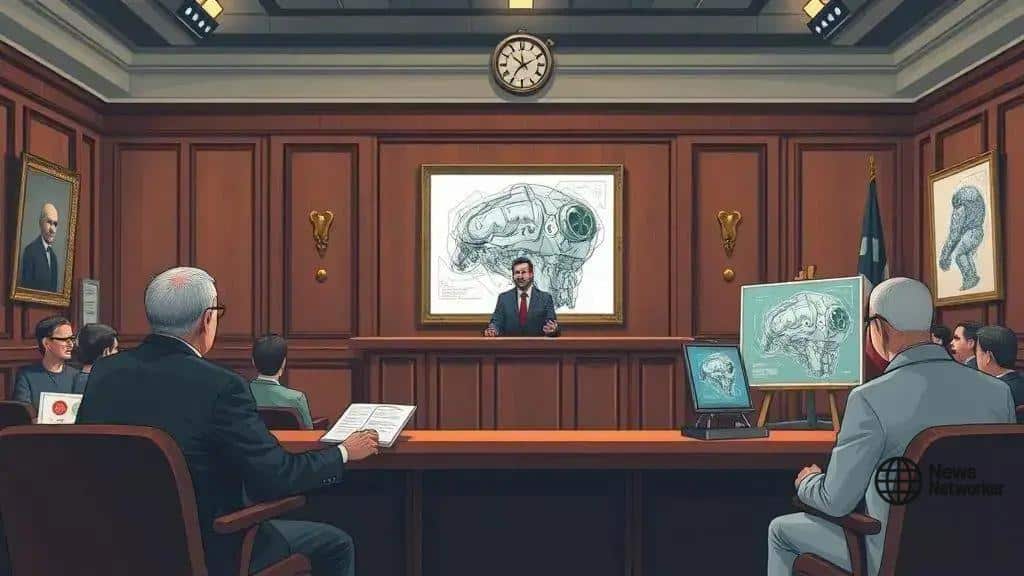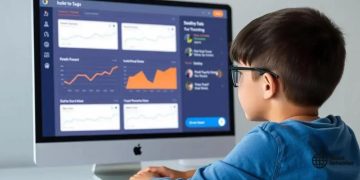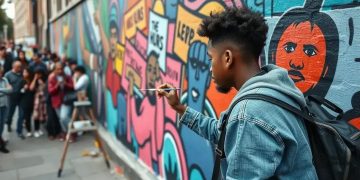The rise of AI-generated art: what you need to know

The rise of AI-generated art raises critical questions about creativity, copyright ownership, and the future of artistic expression, requiring new legislation to address these evolving challenges.
The rise of AI-generated art is changing the landscape of creativity. Have you ever wondered how machines can create art that resonates? Let’s dive into this intriguing topic.
Understanding AI-generated art
Understanding AI-generated art is essential in today’s digital world. As technology evolves, art created by machines is becoming increasingly popular. This raises questions about what qualifies as art and who owns it.
What is AI-generated art?
AI-generated art refers to pieces created by algorithms and machines. These creations can range from paintings to music, and even poetry. They are often made using artificial intelligence, which learns from existing artwork and styles.
How does it work?
Machine learning algorithms analyze vast amounts of data to understand artistic techniques. Once trained, these algorithms can create new pieces that mimic certain styles or fuse different elements together. This process can yield surprising and unique results, pushing the boundaries of traditional art.
- Algorithms study various forms of art.
- They generate new concepts based on learned styles.
- AI can produce art in seconds that might take humans hours.
- Artists can collaborate with AI to enhance creativity.
As AI continues to advance, its capability to create compelling art increases. One interesting aspect of AI-generated art is how it can reflect cultural and societal trends. When machines digest thousands of art pieces, they can identify and incorporate mainstream styles, making their creations relatable. This fusion results in art that resonates with audiences while prompting discussions about creativity and originality.
Challenges arise when discussing copyright issues. Who owns the rights to art created by an AI? This debate is still ongoing in the legal realm as artists and developers strive to navigate these new waters. In a world where machines can replicate human creativity, understanding these dynamics becomes crucial for artists and art lovers alike.
The intersection of technology and creativity
The intersection of technology and creativity has never been more apparent than in the world of art. As artificial intelligence takes on creative tasks, it raises exciting possibilities. Artists can now harness technology to explore new dimensions of creativity and expression.
How Technology Enhances Creativity
Technology offers tools that expand artistic capabilities. With software and AI tools, artists can experiment with styles, colors, and concepts that were once unimaginable. This collaboration leads to unique artworks that blend traditional techniques with modern innovations.
Combining Human and Machine Creativity
When artists work alongside AI, they can find inspiration that might be missed when creating alone. The machine learns from human creativity, allowing for fresh insights and perspectives. Many artists are discovering that AI can serve as a collaborator rather than a replacement.
- AI can generate creative prompts to inspire artists.
- Analytics help in understanding audience preferences.
- Artists can create mixed media that combines physical and digital elements.
- Technology can simulate various artistic styles quickly.
The challenges at this intersection are equally significant. Questions about authenticity arise—if a machine creates art, is it still original? Some critics argue that art must come from human emotion, making the role of AI controversial. However, others celebrate the expanding definitions of art.
Despite these debates, the role of technology in creativity continues to grow. As we advance, understanding this relationship is crucial for both artists and audiences. Ultimately, the fusion of tech and creativity leads to a richer artistic landscape, encouraging experimentation and the breaking of boundaries.
Copyright challenges with AI art

Copyright challenges with AI art are a complex and evolving issue today. As AI-generated artwork becomes more common, it raises questions about ownership and rights. Who is the true creator of an artwork crafted by a machine that learns from established artists?
Understanding Copyright Basics
Copyright laws traditionally protect the rights of human creators. When an artist creates a painting, that artist owns the rights to it. However, with AI, the situation shifts. If an AI generates a piece of art, understanding who holds the copyright becomes murky. Is it the developer of the AI, the user who initiated the creation, or the AI itself?
The Role of Human Input
Another factor in the discussion is the extent of human input in the creative process. If an artist guides the AI and modifies its output, this involvement may strengthen arguments for copyright. Some argue that significant human influence can lead to a shared copyright situation.
- Developers need clarity on ownership when creating AI tools.
- Artists must understand their rights when using AI-generated works.
- Legal frameworks are still adapting to new forms of art.
- Disputes could arise over the originality of AI-generated pieces.
Moreover, the potential for infringement exists as AI learns from existing artwork. If an AI generates a piece that closely resembles an existing artwork, does that constitute copyright infringement? This question haunts many artists and developers in the AI art space.
To navigate these challenges, ongoing discussions and legal revisions are essential. As the rise of AI-generated art progresses, the legal system needs to adapt to ensure fair protections for all creators, whether human or machine. Addressing these copyright issues will play a significant role in the future acceptance of AI art and its artists.
Real-world impacts on artists
The real-world impacts on artists due to the rise of AI-generated art are profound and varied. As technology evolves, artists find themselves navigating a changing landscape. Some view AI as a tool for creative exploration, while others see it as a threat to their livelihoods.
New Opportunities for Creativity
AI opens doors for many artists, enabling them to experiment with new styles and techniques. By collaborating with machine learning tools, artists can enhance their creative process. These technologies provide fresh ideas and perspectives that might not have been discovered otherwise.
Challenges to Traditional Art Forms
However, alongside these opportunities come challenges. Many artists worry that shoppers might prefer the speed and affordability of AI-generated works over traditional art. This shift can lead to decreased demand for handmade pieces, putting financial pressure on artists.
- AI can produce art quickly and at low cost.
- Younger generations may favor digital art over traditional formats.
- Ethical concerns arise regarding the authenticity of AI art.
- Artists are forced to adapt to stay relevant in the changing market.
Moreover, the presence of AI in art can lead to feelings of insecurity among traditional artists. Some may question whether their skills are still valued in a world where machines can replicate creative processes. This sentiment might stifle the motivation to create, as artists might feel overshadowed by AI advancements.
Despite these concerns, many artists embrace AI to expand their practice. They view it as an opportunity to reinvent artistic expression. AI can help them streamline workflows, allowing more time for innovative projects. This balance between tradition and technology highlights the evolving nature of art in a digital age.
Future of AI-generated art and legislation
The future of AI-generated art and legislation is a crucial area of focus as technology continues to advance. As art created by artificial intelligence becomes more widespread, the need for clear legal frameworks is essential. These frameworks will help protect artists and define the rights associated with AI-generated works.
Anticipated Changes in Laws
One of the main discussions is how existing copyright laws will adapt to include AI-generated content. Currently, these laws primarily recognize human creators. Legislators are considering amendments to account for the unique nature of AI creations. This evolution could bring clarity and structure to a rapidly changing industry.
The Role of Policy Makers
Policy makers will play a vital role in shaping the future landscape of art and technology. They must engage with artists, technologists, and legal experts to understand the nuances of AI-generated art. By doing so, they can create balanced policies that protect human creativity while encouraging innovation.
- Possible frameworks might define rights for AI creators.
- Policies could establish guidelines for using AI in creative processes.
- Legislation may address ethical concerns surrounding AI use.
- Continual dialogue between stakeholders is essential for effective laws.
As we look ahead, fostering collaboration between technologists and artists is crucial. This partnership can lead to new models that respect both the artist’s intent and the capabilities of AI. Furthermore, educational initiatives may help artists and consumers understand the implications of AI-generated works.
Ultimately, the balance between innovation and protection will define the future of AI-generated art. As regulations evolve, they will shape not only how art is created but also how it is perceived and valued in society.
FAQ – Frequently Asked Questions about AI-Generated Art
What is AI-generated art?
AI-generated art is artwork created using artificial intelligence algorithms that learn from existing art styles and techniques.
How does AI influence traditional art?
AI can enhance traditional art by providing new tools for creativity while also presenting challenges, such as competition for attention and sales.
Are there legal challenges with AI-generated art?
Yes, copyright issues arise over who owns the rights to AI-generated works, as current laws mostly recognize human creators.
What does the future hold for AI and art?
The future will likely see greater collaboration between artists and AI, alongside evolved legislation to protect artistic rights and foster innovation.





